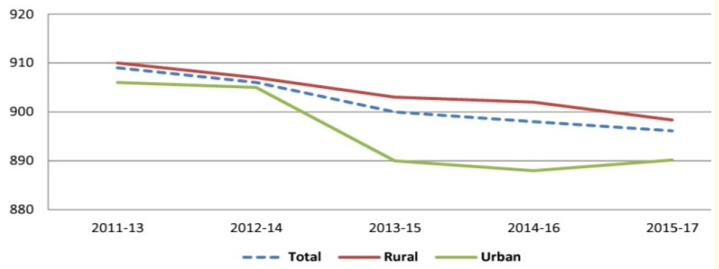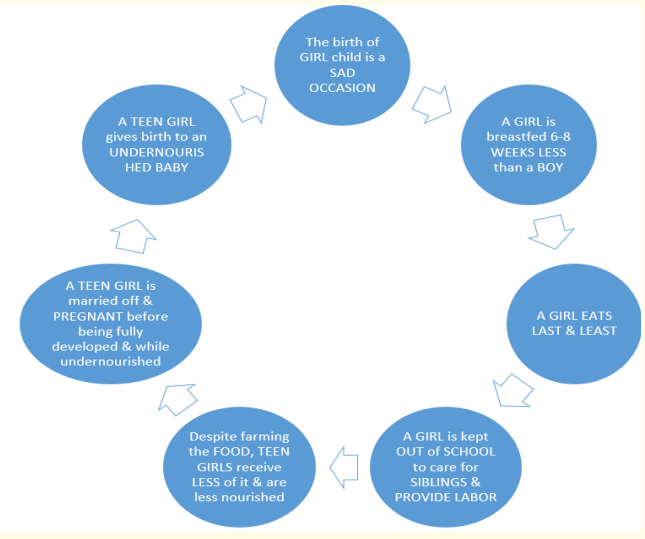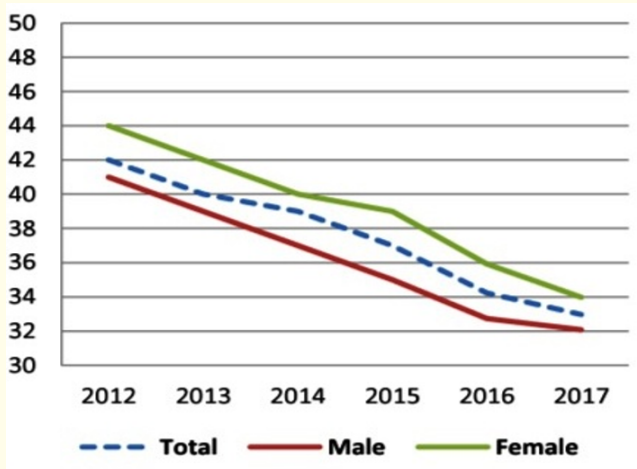Bhag Singh Karnawat1*, Khushboo Agarwal2 and Kirti Dave3
1Senior Professor and Unit Head, Department of Pediatrics, JLN Medical College, Ajmer, India
2Senior Resident, Department of Pediatrics, JLN Medical College, Ajmer, India
3Junior Resident, Department of Pediatrics, JLN Medical College, Ajmer, India
*Corresponding Author: Bhag Singh Karnawat, Senior Professor and Unit Head, Department of Pediatrics JLN Medical College, Ajmer, India.
Received: October 11, 2019; Published: November 05, 2019
Citation: Bhag Singh Karnawat., et al. “Girl Child in India- Present Plight to Future Bright ”. Acta Scientific Paediatrics 2.12 (2019):14-18.
Census 2011 reflected a declining trend in the Child Sex Ratio (CSR) between 0-6 years, reaching an all time nadir of 918 girls to 1000 boys. CSR reflects both, prenatal as well as post birth discrimination against girls. Easy availability of diagnostic tool has been contributory in increasing sex selective elimination leading to low Sex Ratio at Birth (SRB). SRB for period 2008-10 was 908 as against the internationally observed normal SRB of 952. Strong socio-cultural biases, preference for sons and discrimination towards daughters have accentuated the problem. A host of laws have been enacted from time to time to save the girl child in India. PCPNDT (Pre-conception and Pre-natal Diagnostic Techniques) Act 1994 (Amended in 2016) has come as a boon to curb the menace of female foeticide. A number of girl child welfare programs and schemes have been initiated to uplift the quality of their life, latest being “ The Beti Bachao , Beti Padhao (BBBP) Abhiyan “ launched in 2018. Some of the important laws/ programs are comprehensively reviewed herewith which would be instrumental in improving the life of a girl child in India- both quantitatively as well as qualitatively.
Keywords: Girl Child; Female Foeticide, Child Sex Ratio (CSR); PCPNDT Act; ‘The Beti Bachao, Beti Padhao (BBBP) Abhiyan
It is a sad paradox that when we, on one hand, venerate our country as Bharat Mata and worship Durga, on the other hand, carry out reprehensible practices like female foeticide, girl child sex trafficking, dowry- deaths, bride- burning, etc. Girls are treated as a burden- “paraya dhan”. A girl child is increasingly being excluded from life itself.
Census-2011 reflected a declining trend in the Child Sex Ratio (CSR) between 0-6 years. An all-time low of 918 girls to 1000 boys was startling. The decline in the CSR is a major indicator of women disempowerment. CSR reflects both, pre-birth discrimination manifested through gender biased sex selection-as well as post-birth discrimination against girls [1]. Though the CSR is influenced by number of factors such as under registration of girls, differential infant and child mortality, strong socio-cultural biases as mentioned above, it is in large measure determined by Sex Ratio at Birth (SRB). SRB is defined as number of girls born per 1000 boys. The SRB for the period 2008-10 was 908 (Figure 1) as against the internationally observed normal SRB of 952; clearly pointing out to lesser number of girls being born than the boys in India. Easy availability and affordability of diagnostic tools has been contributory in increasing Sex Selective Elimination (SSE) leading to low SRB. Strong socio-cultural biases leading to preference for sons and discrimination towards daughters have accentuated the problem.

Figure 1: Sex ratio at Birth..
The abnormal sex ratio leads to a lot of unpleasant long-term consequences. There is increased violence against women- one hears of repugnant incidences of infants being raped. Young men cannot find brides. The frustrated youth either turns to commercial sex workers and are exposed to HIV and other STDs or such persons can turn to antisocial or violent crimes and lured into antinational militant activities.
According to global statistics, women make up more than twothird of the world’s 796 million illiterate people. Furthermore, just 39 percent of rural girls attend secondary level schools. This is far fewer than rural boys (45 percent), urban girls (59 percent) and urban boys (60 percent).
According to census of 2011, India’s female literacy rate is 65.46 percent, significantly lower than the world average of 79.7 percent. The Right to Education (RtE) Act, introduced in 2009 making elementary education free and compulsory, has been a shot in the arm for many in our country. Nevertheless, statistics reveal the dismal gap between states – while states like Kerala paint a rosy picture of women’s education in India with 92.07 percent female literacy, relatively backward states such as Bihar with 51.5 percent female literacy rate highlight the importance of sustained campaign in favour of women’s education in India.
Female education in other developing countries is also in dire state. In Pakistan a half-kilometre increase in the distance to school will decrease girls' enrolment by 20 percent. In Cambodia, 48 percent of rural women are illiterate compared to 14 percent of rural men.
Improving female education is an essential prerequisite for women empowerment and family well-being. A recent study has shown that maternal education significantly influences health seeking behavior of mothers e.g. immunization status of their children [4].
Generally a girl child in India is discriminated and is less priviledged. Their health and medical issues are not addressed as promptly and adequately as their male counterparts. This saga of problems begins well from the birth of a girl child and runs to elder age till she herself becomes a mother. This deplorable life cycle of a girl in developing world is vividly depicted in Figure 2 [5].

Figure 2: The life of a girl child in the developing world.
A girl child is not even given full benefit of free preventive and curative health services provided by the government. According to NFHS-3 data immunization rates for 2 year old girls was 41.7% as compared to 45.3% for boys. Obviously, this lower protection leads to increased morbidity/ mortality in a girl child due to vaccine preventable diseases.
According to UNICEF- 2011, 47% of teenage girls in India aged 15-19 years old are underweight which is highest in world. More than half of these girls (56%) are anemic which increases the risk of maternal, foetal and neonatal mortality significantly [6]. Malnutrition and anemia in a girl leads to poor physical growth and mental development which is further aggravated with start of menses during adolescence. Use of unhygienic menstrual material makes her susceptible to urogenital infection.
A study from South Asia suggests gendered effects of siblings on child malnutrition in India, Bangladesh and Nepal. Having brothers heighten girl’s risk for acute malnutrition whereas having multiple sisters increased girl's risk for chronic malnutrition; whereas boy’s malnutrition is less affected by gender of siblings [7]. In India roughly 43% of girls are married and 22% give birth before they turn 18, due to this every year 6000 teenage mothers loose their lives. An average of 239000 excess death of girls per year under age of 5 years or 2.4 million in a decade occurs in India. This excess female child death is found in 90% of the districts in the country [8]. Statistics show that female infant mortality rate (IMR) is higher than the male IMR (Figure 3).

Figure 3: Infant Mortality Rate.
Coordinated efforts are needed to ensure survival, protection, optimal upbringing and education of girl child to help realize her full potential. Various laws and schemes having direct or indirect beneficial impact on life of girl child are enlisted below:
Some of the most important laws/ programmes are described in detail underneath :-
One of the major causes of steep decline in the CSR is female foeticide/infanticide and discrimination between girl and boy child. Under this scheme, the district authorities monitor villages and ensure that there is no sex determination test conducted in any health care establishment. There are awareness campaigns where parents and families are educated not to go for the test and embrace girl child. Intervention is focussed to enforce existing Legislations and Acts, especially to strengthen the implementation of Pre Conception and Pre-Natal Diagnostic Techniques (Prohibition of Sex Selection) Act, 1994 (PCPNDT Act) with stringent punishments for violations of the law. The role of medical professionals in this regard has not been the most laudatory. There may have been a few black sheep who conducted pre-natal sex determination and female foeticide, but the rest of the doctors should have put a stop to this. Regulatory bodies like MCI and IMA should have been more proactive in weeding out these nasty elements from the profession.
Unique features adopted by Rajasthan Government in implementing PCPNDT are highlighted below:
Societal changes must come about through a churning in society. If that is not forthcoming, the government must nudge in these changes by either judicial activism, legislative or executive initiative, or through journalistic intervention of an independent Press and TV. This campaign was launched by Prime Minister Narendra Modi on 8th March 2018 (i.e. World Women Day) from Rajasthan, to address the decline in CSR through a mass campaign across the country, and focussed intervention and multi- pronged action in 100 gender critical districts. There are two main objectives of the scheme – preventing female foeticide and promoting education of girl child. Nationwide campaigns are conducted to induce mindset change in people through training, raising awareness and importance of educating girl child. This joint initiative was taken by Ministry of Women and Child Development, Ministry of Human Resource and Development And Ministry of Health and Family Welfare. Recently this programme along with Nutrition Mission was expanded to all districts of India.
The scheme ensures well being, protection and security of girl child after her birth. With options like ' Sukanya Samriddhi', parents or legal guardian can open a small savings account for girls. A small contribution is needed for 14 years and the next 7 years, one will be able to earn interest on it, thus the account matures at 21 years.
One of the major discrimination in India is female education. The scheme spreads awareness and campaigns to educate female girl child so that they grow up to become self empowered. The district level officials educate people with importance of girl education. Free elementary education is provided to girls of under privileged families. The aim is to spread 100% education and literacy amongst females. There is positive impact after the implementation of this scheme, as there is increase in CSR. More families welcome the birth of a girl child happily- the stigma no longer exists. There is increase in education levels of girls after implementation of BBBP scheme.
Congratulatory message signed by the Chief Minister of Rajasthan is given to every mother who comes to government institution for delivery and delivers a girl child. From birth of a girl child to her passing 12th standard education from a government school, a total sum of Rs 50,000 is given in installments.
Other suggested initiatives include:
In comparison to their male counterparts, the girl child in India is largely marginalized and discriminated, not only in socioeconomic and educational aspects, but also in medical and health related issues. Thanks to implementation of different legal and legislative actions as well as launching of various girl child welfare and public awareness programmes by the government; this present plight of female child is slowly but surely going to change into bright future. To ensure this transformation the society also need to change its mind set. To quote.
“We've begun to raise daughters more like sons, but few have the courage to raise our sons more like our daughters”.
Gloria Steinem
Copyright: © 2019 Bhag Singh Karnawat., et al. This is an open-access article distributed under the terms of the Creative Commons Attribution License, which permits unrestricted use, distribution, and reproduction in any medium, provided the original author and source are credited.
ff
© 2024 Acta Scientific, All rights reserved.